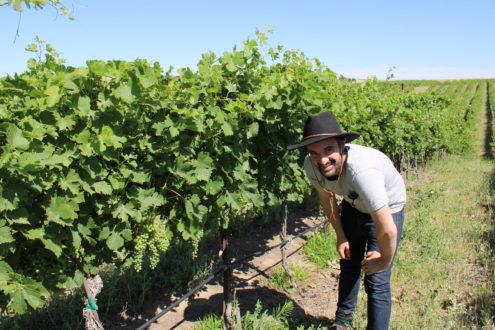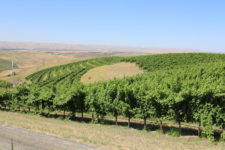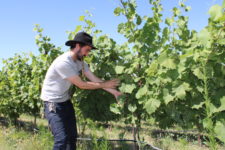

Oct 10, 2022Walla Walla vineyard focuses on sustainability
High on the hills of Washington’s Walla Walla Valley, Woodward Canyon Winery practices sustainable growing methods, using beneficial insects to guard against pests and a focus on soil health.
Woodward Canyon is the region’s second-oldest winery and the western-most vineyard in the Walla Walla Valley Appellation. The Small family has farmed in the area west of Walla Walla for four generations.
The Lowden, Washington, winery harvests winegrapes on 40 acres from late August through October. It markets the varietals, which include Cabernet Sauvignons, Bordeaux-style blends, merlots and Chardonnays, throughout the U.S. and in Japan, China, South Korea and Europe.


The winery Army buddies Rick Small and Gary Figgins hung out on the weekends, playing guitars and drinking the hobby wines they made in their garages. In 1977, Figgins’ Leonetti Cellar became southeast Washington’s first winery.
In 1976, Small and his wife Darcey planted their first winegrapes on the family’s dryland wheat ranch, establishing the Woodward Canyon Estate Vineyard with the winery following in 1981. The Smalls helped secure federal approval of the Walla Walla Valley American Viticultural Area in 1984; it has the highest concentration of wineries in the state at 120, with about 3,000 acres of winegrapes.
The Small’s children, Sager and Jordan, own and run the operation. Sager is vineyard manager and his sister Jordan is general manager. While officially retired, Rick and Darcey Small remain involved in the family business. At 75, Rick Small walks through the vineyards regularly and promotes the company’s wine internationally.
Elevation is key
If the vineyard was any lower than its 900-foot elevation, cold fronts would bring a higher frost risk. Usually windy and sunny, the combination of heat and wind produce smaller berries from the favorable skin-to-juice ratio. Plant competition is heightened in the high density smaller vines.
Leaves are manually removed to combat powdery mildew, which has become a large issue throughout the valley this year. The Smalls limit mowing to later in the year, a couple of times a year at most. The reduced mowing helps grass reseed. Frequent mowing limits favorable seedhead, important in attracting beneficial insects.
Five acres of green belts adjacent to the vineyards include western juniper and ponderosa pine groves, western sage brush, arrow leaf balsam root and other native species, including perennial wildflowers.
Sager Small catalogs the vineyard’s weeds and native plants and studies insects.


“There’s the simple adage of you will never have the biocontrol if you don’t have the pest in your vineyard,” he said. “In order to have the capacity to keep pests, it’s not about not having any pests in your vineyard. It’s about having an amount of pests that won’t be detrimental to your crop.”
Sagar Small, who earned degrees in culinary winemaking and winegrowing and is finishing coursework for a bachelor’s degree in environmental sciences, studies grasses that work well in vineyards. Collaborating with Washington State University Extension personnel, he monitors beneficial insects through trapping. Wasps and soil samples are tracked.
Woodward Canyon also limits spraying, applying crop protectants only when necessary, he said.
Soil factor
Growing winegrapes in a government designated high erosion site, soil health remains critical for Woodward Canyon Winery, especially in the vineyard’s desert ecology. Biocrust can be protected by simple practices, such as avoiding disturbing it by not walking on it, to keep the soil intact.
“Everything about a cultivated crop depends on the soil,” Sager Small said. “If you don’t take care of the land, it will degrade on you. The wind will blow away your topsoil and you won’t have any beneficial insects around. If your soil isn’t there, you won’t be able to farm most anything without a ton of intervention.”
Sager Small uses a hybrid system of organic and regenerative agricultural practices.
While Woodward Canyon’s winegrapes aren’t organic, its crop protectants, which include Stylet-Oil and micronized sulfur, are common organic fungicides.
“The thing with sustainability or regenerative ag programs is you’re never ever really done,” he said. “You are always wanting to find new ways to keep getting better every year to reduce your impacts or reintroduce a new species of plants. If we could, we would bring our land back to the state of where it almost was before man arrived.”
In the valley’s fertile winegrape industry, growers continue increasing plantings. Growers tell Sager Small they’re planting many new varietals, which speaks to the region’s importance. “People seem to really like the wine here,” he said. “People keep moving to plant more vines. It’s a bellwether of good things.”
—Doug Ohlemeier, assistant editor
Top photo: Sager Small of Woodward Canyon Winery and Merlot winegrapes. Photos: Doug Ohlemeier
Middle Photo: Woodward Canyon’s vineyards are on the west side of the Walla Walley Valley in eastern Washington.
Bottom photo: Sager Small of Woodward Canyon Winery examines Chardonnay grapes.














